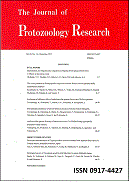All issues

Volume 15 (2005)
- Issue 3-4 Pages 29-
- Issue 1-2 Pages 1-
Volume 15, Issue 3-4
The Journal of Protozoology Research
Displaying 1-4 of 4 articles from this issue
- |<
- <
- 1
- >
- >|
-
Shiho Kamiya, Noriyuki Takabatake, Kei Fujii, Masashi Okamura, Hi ...2005 Volume 15 Issue 3-4 Pages 29-40
Published: 2005
Released on J-STAGE: December 18, 2019
JOURNAL FREE ACCESSBabesia spp. are major hemoprotozoan parasites in animals. Exoantigens, which are soluble antigens released by the parasites during their asexual development, have been successfully applied for the development of a vaccine against babesiosis. In this study, we examined the ability of exoantigens to induce protective immunity in mice against a rodent Babesia parasite, Babesia rodhaini. The BALB/c mice immunized with the blood plasma fraction of B. rodhaini-infected mice (B. rodhaini exoantigens) showed a significant decrease in the lethal rate when challenged with B. rodhaini. Western blot analysis with anti-B. rodhaini exoantigen immune serum specifically detected at least eleven proteins in the lysate of B. rodhaini-infected erythrocytes. Next, a cDNA expression phage library of B. rodhaini was immunoscreened with the anti-B. rodhaini exoantigen immune serum, and three positive cDNA clones were obtained. However, compared to control mice, the mice immunized with each of these recombinant proteins expressed in E. coli or insect cells did not show significantly prolonged survivals after the challenge infection. These findings indicated that B. rodhaini-derived exoantigens contain vaccine candidates inducible of protective immunity in mice, but further investigation is needed to identify the target antigens responsible for the protection.View full abstractDownload PDF (463K) -
Takashi Ohmori, Satoshi Tamahara, Pham Ngoc Thi, Mizuki Tomihari, ...2005 Volume 15 Issue 3-4 Pages 41-47
Published: 2005
Released on J-STAGE: December 18, 2019
JOURNAL FREE ACCESSInterleukin-12 (IL-12) is one of the most important factors for the host’s protective immune res ponse against protozoan infection. To evaluate the effect of bioactive form of IL-12(IL-12p70), expression of IFN-γmRNA and IL-4 mRNA in splenic CD4 positive T cells, anti-parasite delayed type hypersensitivity (DTH), and serum and splenic IL-12p70 concentration were examined in Babesia microti and B. rodhaini infected mice. The expression of IFN-γmRNA as a marker of Th1 cell differentiation was detected in splenic CD4 positive T cells in B. microti infected mice. Activation of DTH response as a marker of cell-mediated immune response was also observed from 2 days after the infection with B. microti, while no response was detected in B. rodhaini infected mice. Serum IL-12p70 was not detected in both B. microti and B. rodhaini infected mice, however, splenic IL-12p70 concentration increased significantly in B. microti infected mice with peaks at 30 hrs and 4 days after the infection. From these results, splenic IL-12p70 increased at 30 hrs after the B. microti infection was considered to closely relate with Th1 cell differentiation followed by cell-mediated immune response in mice.View full abstractDownload PDF (121K) -
Rie Hashiguchi-Kato, Pham Ngoc Thi, Takashi Ohmori, Satoshi Tamaha ...2005 Volume 15 Issue 3-4 Pages 48-56
Published: 2005
Released on J-STAGE: December 18, 2019
JOURNAL FREE ACCESSStimulatory factors for interleukin 12 (IL-12) production associated with Babesia microti and Babesia rodhaini infected erythrocytes were examined using an in vitro assay system established, since a remarkable increase of serum IL-12 concentration and differentiation of helper T cell (Th cell) into helper T cell type 1 (Th1 cell) was observed in early phase of infection with Babesia spp. in mice. To investigate direct stimulating activity of infected erythrocytes for IL-12 production, intact splenic macrophages were co-cultured with them and examined the expression of IL-12 mRNA by reverse transcription-polymerase chain reaction (RT-PCR). Both B. microti and B. rodhaini infected erythrocytes elicited IL-12 mRNA expression in co-cultured macrophages. Since only the supernatant obtained from the cultured medium of infected erythrocytes showed an activity for IL-12 production from macrophages, the supernatant was collected, concentrated, and heated, followed by the collection of soluble fraction. As the heat stable soluble supernatant showed an IL-12 production activity, it was fractionated by gel filtration. The elution profile of the heat stable soluble supernatant from B. microti infected erythrocytes was quite different to that from B. rodhaini infected and non-infected erythrocytes. The differences of stimulatory activity were also observed in the fraction of eluate, especially Fraction 3, between B. microti infected erythrocytes, and B. rodhaini infected and non-infected erythrocytes. These results suggested that B. microti infected erythrocytes and/or B. microti itself released some factors to stimulate IL-12 production from splenic macrophages, resulted in the Th1 differentiation.View full abstractDownload PDF (119K) -
Martin R. Ruheta, Noboru Inoue, Kozo Fujisaki2005 Volume 15 Issue 3-4 Pages 57-62
Published: 2005
Released on J-STAGE: December 18, 2019
JOURNAL FREE ACCESSOrnithodoros moubata was fed artificially through a parafilm membrane with two types of artificial meals. The first type was composed of bovine and horse red blood cells suspended in phosphate buffered saline or fetal bovine serum (FBS). The second type was composed of FBS alone. Engorgement and post engorgement survival rates of the ticks after feeding on the two types of meals were compared and analysed statistically. FBS was found to be superior to red blood cell meals. Eventually two batches of FBS from different manufacturers were used to feed the ticks through artificial membrane. Engorgement and post engorgement survival rates were again compared and analysed statistically. There was no significant difference between the two lots. Finally O. moubata was fed on FBS and successful reproductive cycle followed up to the third generation.View full abstractDownload PDF (38K)
- |<
- <
- 1
- >
- >|